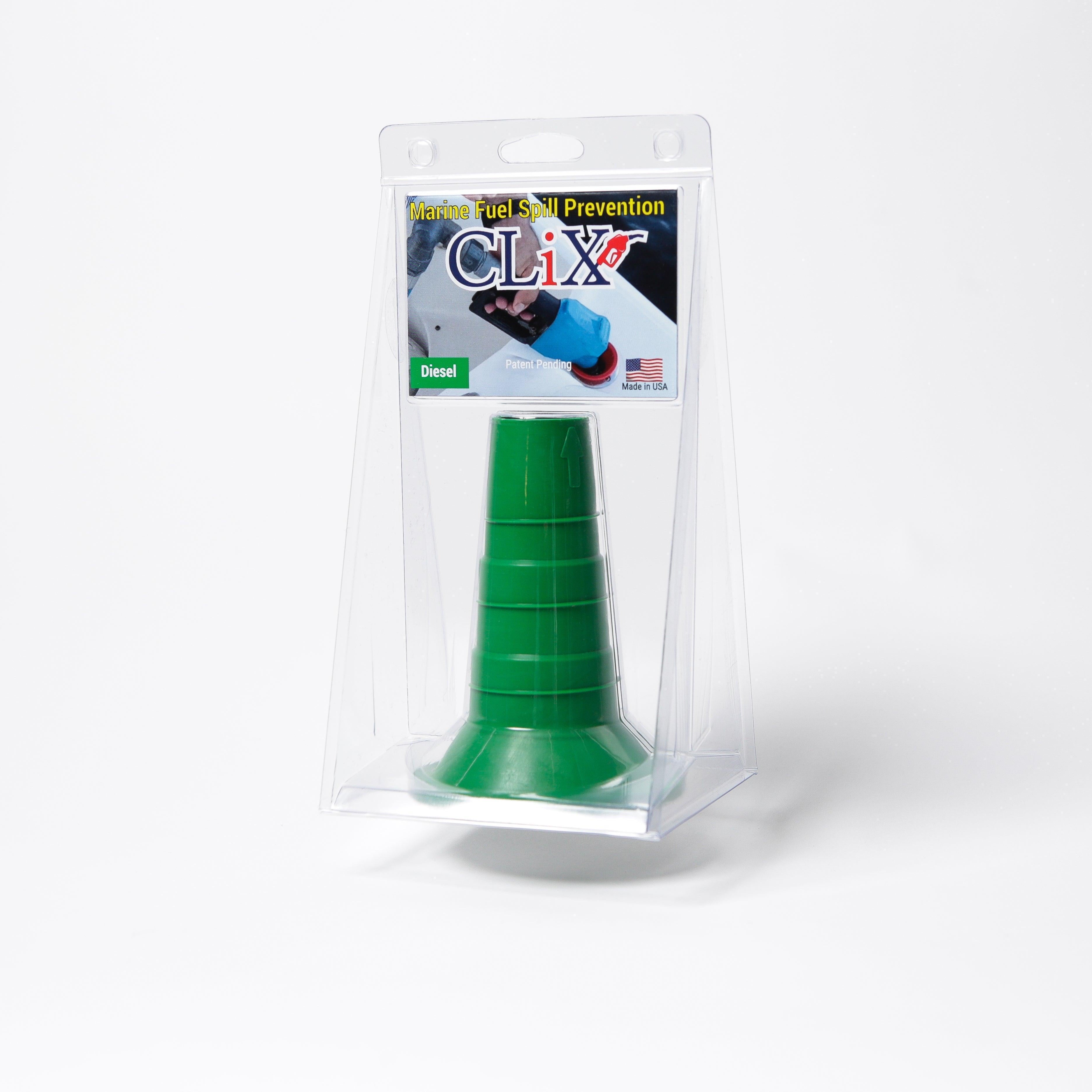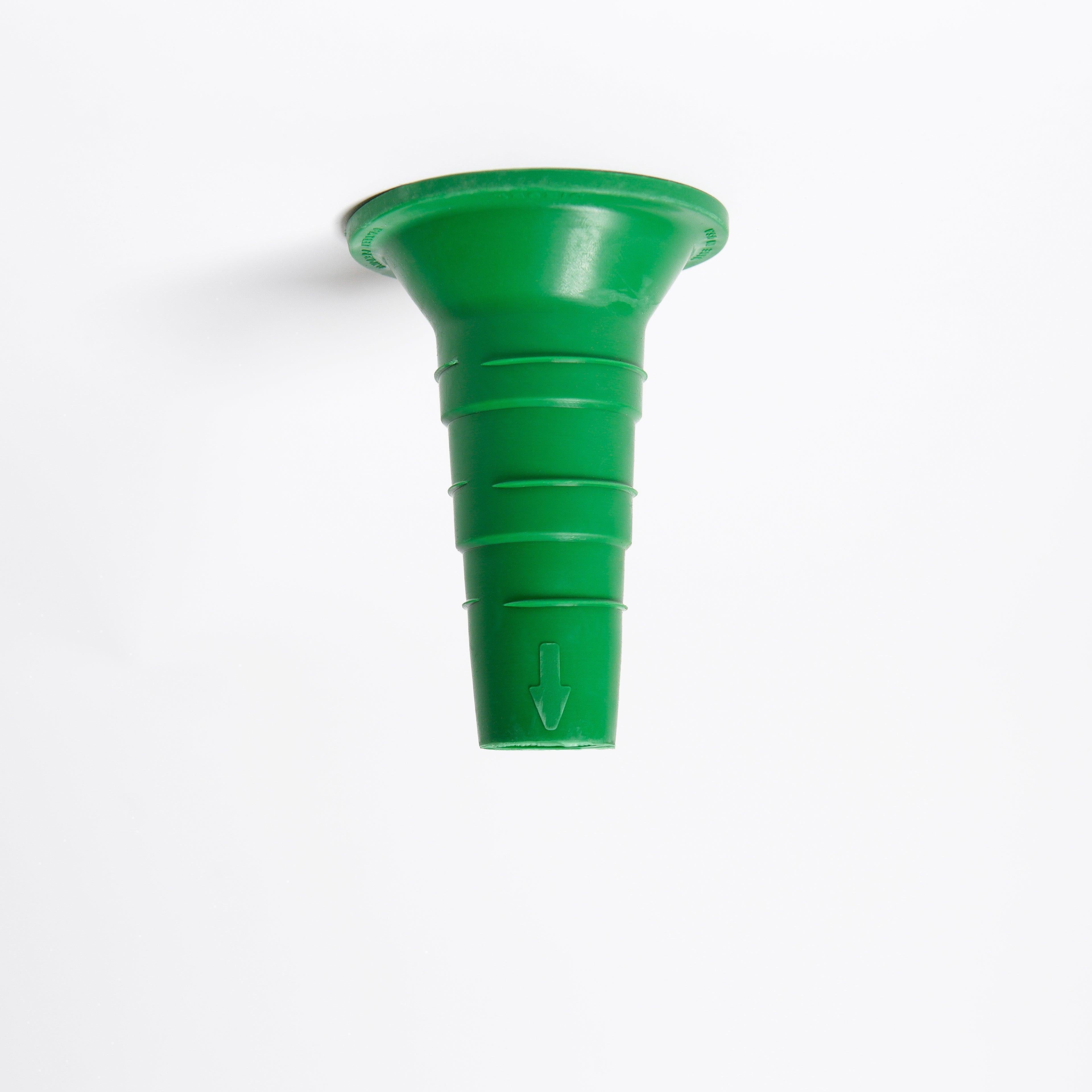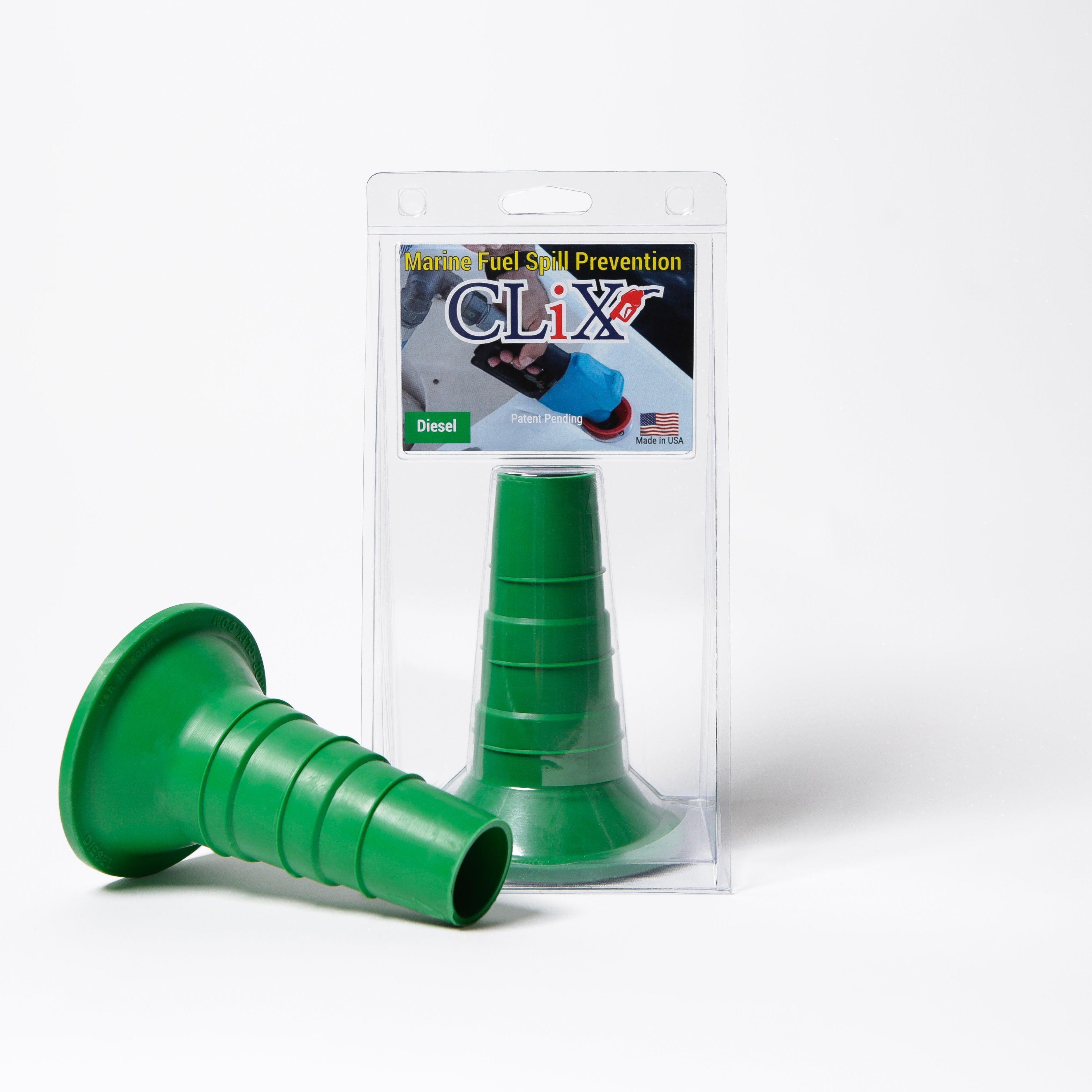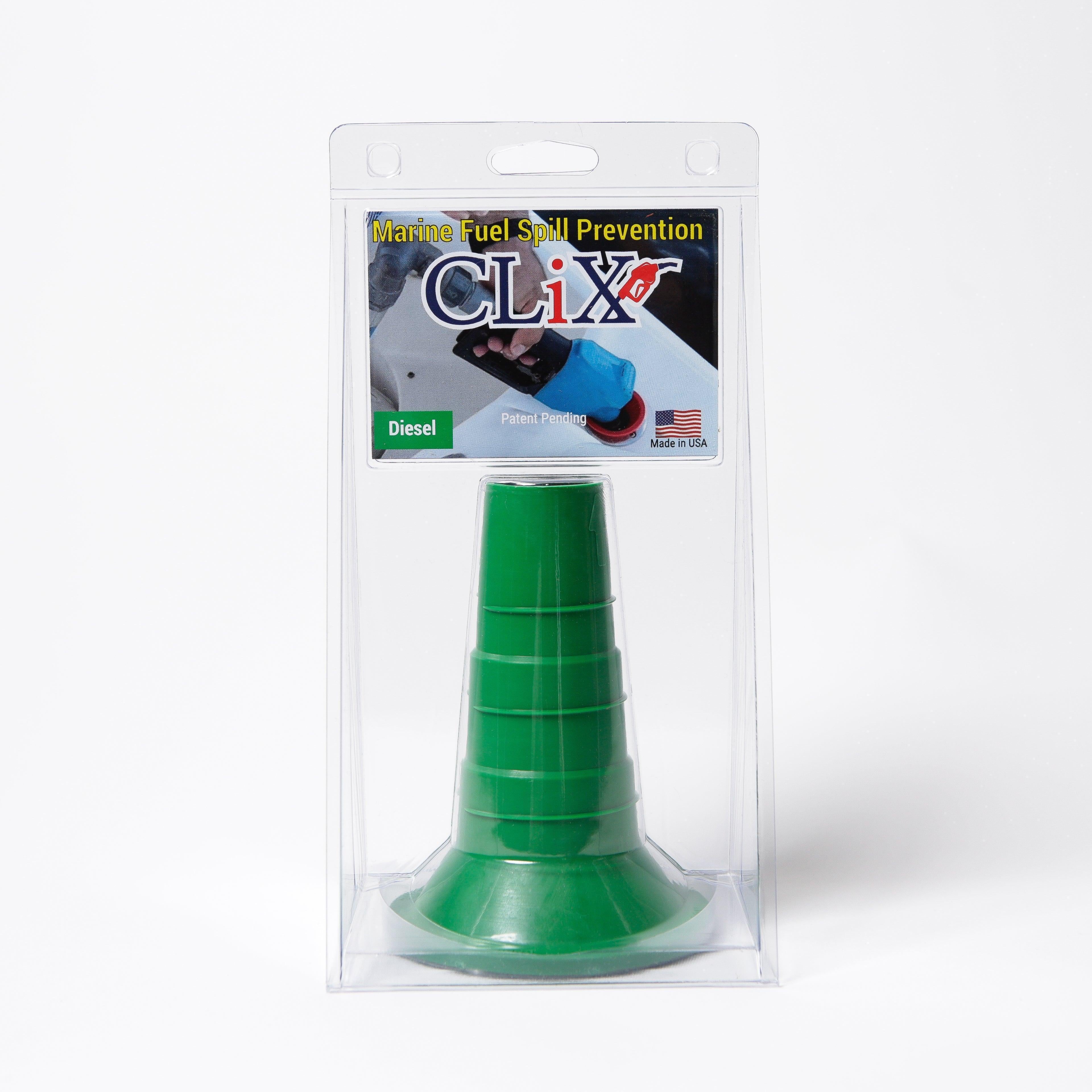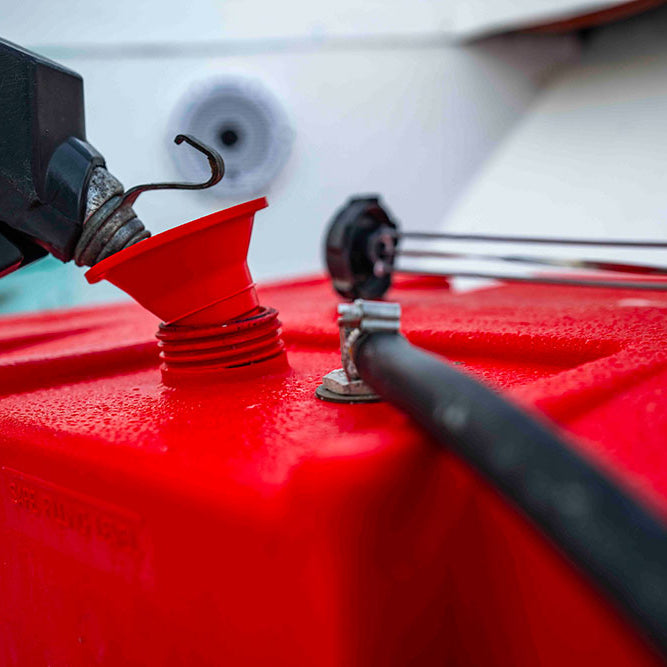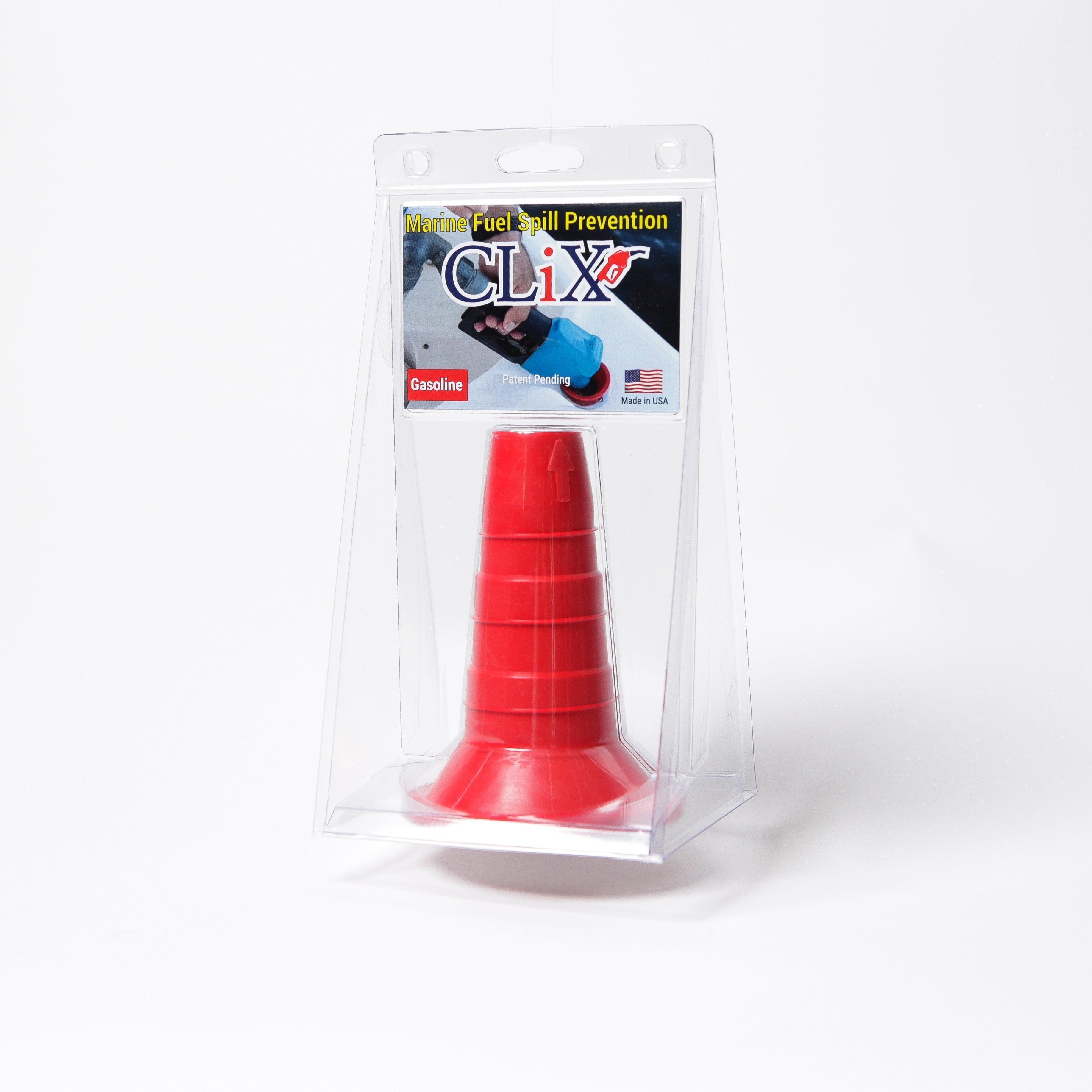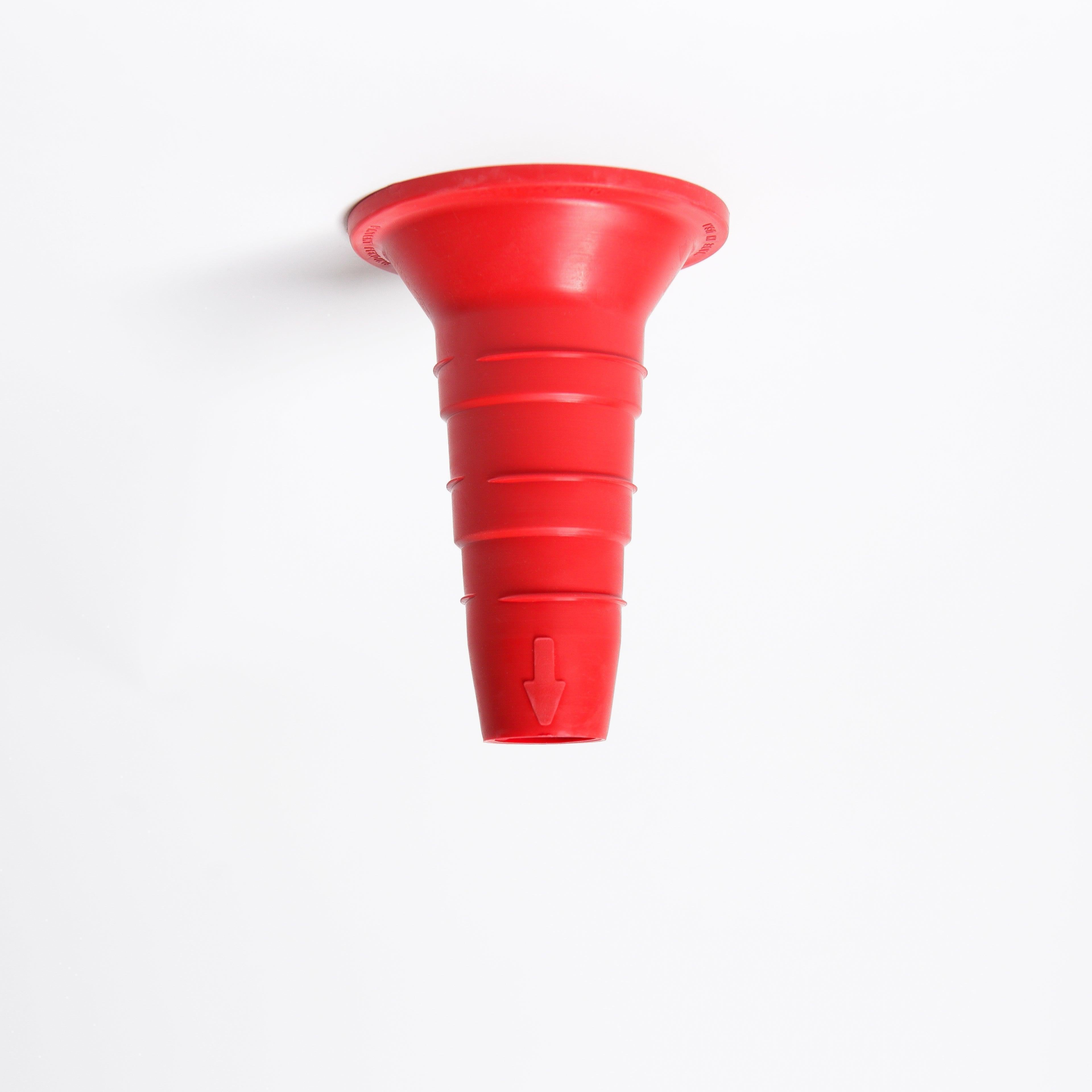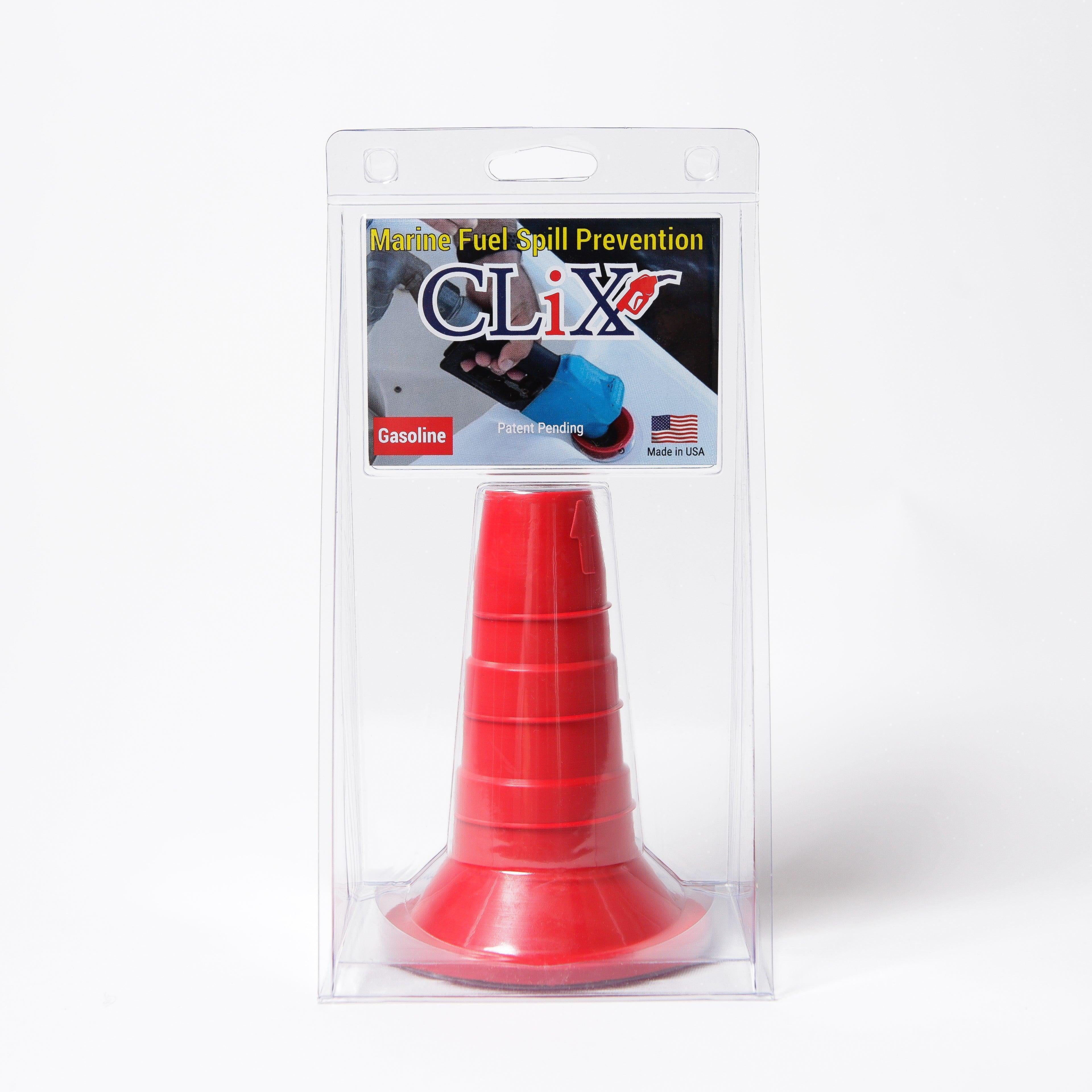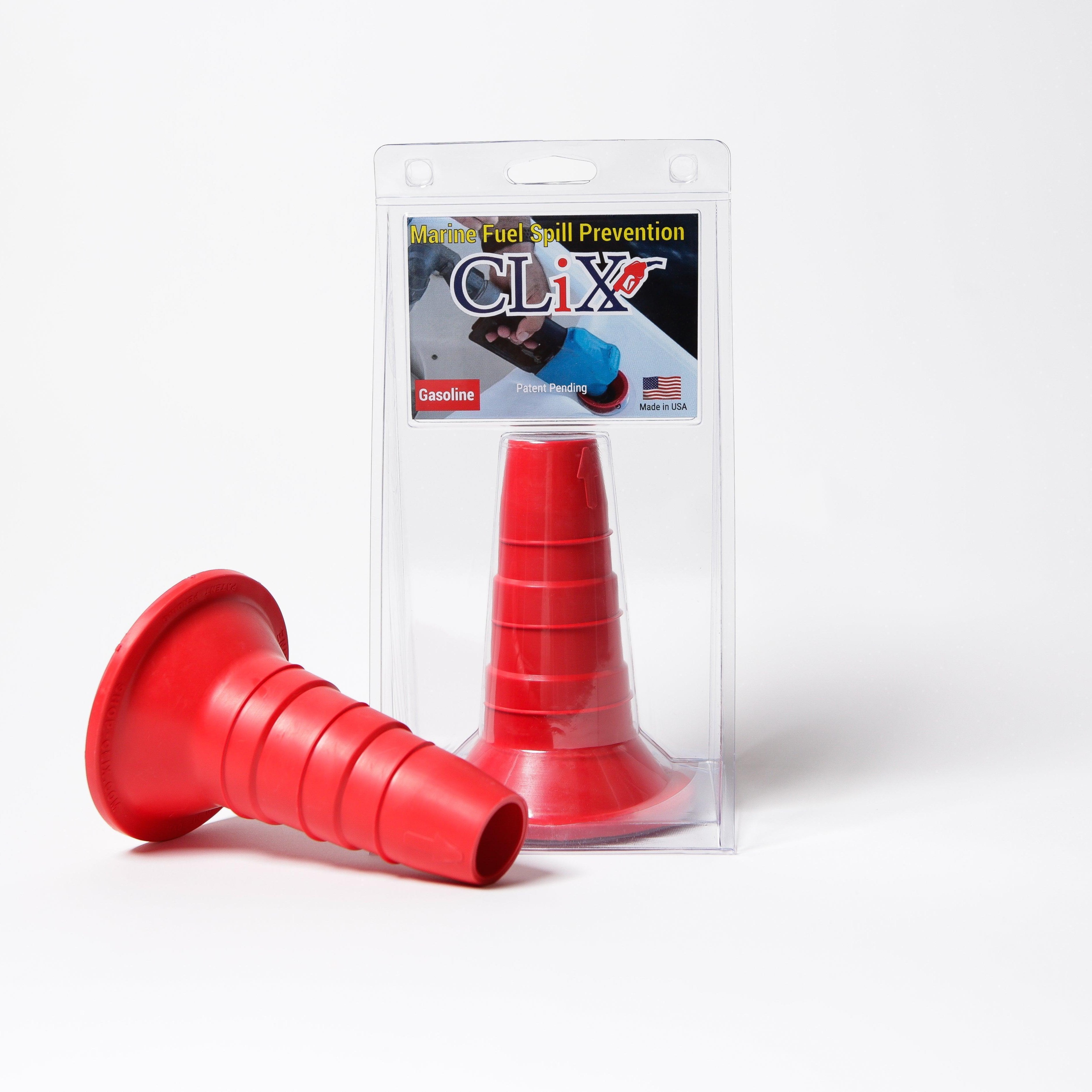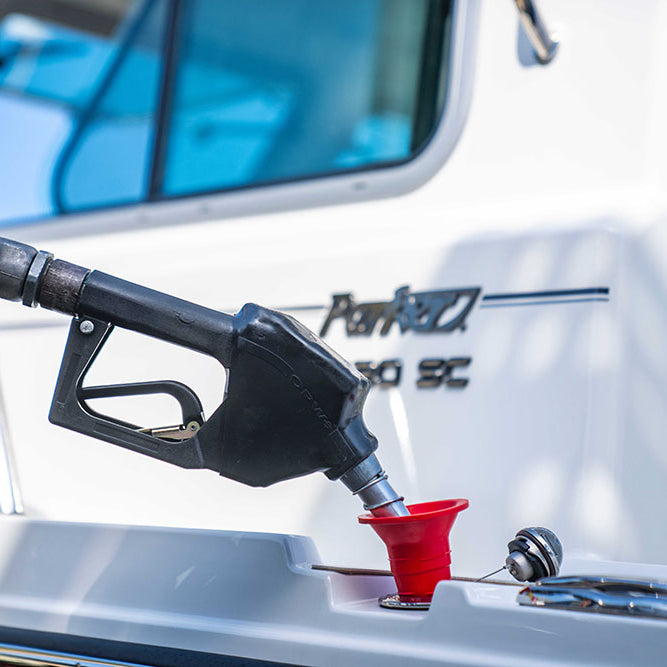You've probably heard the term tossed around in car forums or at the local track, but what exactly is a fuel catch can? And more importantly, why should you care?
Think of it as a small, dedicated bodyguard for your engine. It’s a simple but incredibly effective filter that sits in line between your engine's crankcase and the intake manifold. Its one and only job is to intercept a nasty cocktail of oil vapor, unburnt fuel, and moisture before it can get sucked back into your engine to be burned.
What Is a Fuel Catch Can and Why Does It Matter?
Every internal combustion engine produces something called "blow-by." It's an unavoidable part of how they work. During combustion, immense pressure forces a small amount of unburnt fuel, oil mist, and combustion gases past the piston rings and down into the crankcase.
From the factory, your car’s Positive Crankcase Ventilation (PCV) system is designed to handle this. It simply sucks these vapors out of the crankcase and routes them straight back into your engine’s intake to be burned off. It’s a solution that works for emissions, but it comes at a cost to your engine's long-term health and performance.
That oily, gunky vapor coats everything in its path—the intake manifold, ports, and especially the back of your intake valves. A fuel catch can fixes this by acting as a trap. It lets the air pass through, but forces the heavier oil and fuel droplets to fall out of suspension, collecting harmlessly in the bottom of the can. The result? Only clean air makes it back into your engine.
Preventing Performance-Robbing Buildup
So, why is this gunk so bad? This buildup on your intake valves doesn't just look gross; it actively hurts performance. The carbon deposit acts like a sponge, soaking up fuel and disrupting the carefully calibrated air-fuel mixture your engine relies on.
Left unchecked, this can lead to some frustrating issues:
- A noticeable drop in horsepower and torque.
- Worse gas mileage and sluggish throttle response.
- Rough idling, hesitation, or even engine misfires.
A catch can is one of the best preventative mods you can make, especially if you have a modern direct-injection, turbocharged, or supercharged engine. These engines are far more susceptible to intake valve deposits and produce more blow-by, making a catch can almost essential for maintaining peak performance.
Of course, keeping airborne gunk out is only half the battle. Making sure the fuel going into your tank is clean from the start is just as important. For more on that, check out our guide on how a fuel filter funnel protects your engine.
Catch cans have moved from being a niche upgrade for racers to a smart investment for everyday drivers. You don’t have to take my word for it—just look at where people are spending their money.
This isn't just an enthusiast trend; it's a massive market. Valued at USD 9.83 billion, the global oil catch can market shows just how many vehicle owners are getting serious about protecting their engines. With projections showing it will grow to over USD 13.65 billion by 2031, it’s clear that engine longevity is a top priority for drivers everywhere.
Let’s take a quick look at the specific problems a fuel catch can is designed to prevent.
Engine Problems Solved by a Fuel Catch Can
| Engine Problem | How a Catch Can Solves It |
|---|---|
| Carbon Buildup | Traps oil and fuel vapor before they bake onto intake valves and ports. |
| Reduced Power & Torque | Keeps the intake path clear, ensuring optimal airflow and a correct air-fuel ratio. |
| Lowered Fuel Economy | Prevents fuel-absorbing deposits, allowing for a more efficient combustion cycle. |
| Potential Misfires | Maintains clean valves and spark plugs, which helps prevent ignition timing issues. |
| Oil Contamination | Stops blow-by from contaminating the fresh air/fuel mixture entering the cylinders. |
As you can see, this simple device provides a powerful defense against some of the most common causes of declining engine performance and health.
How a Fuel Catch Can Actually Works
To really get what a fuel catch can does, you have to look past the polished metal and understand the clever process happening inside. Fundamentally, it's a gatekeeper. It intercepts the oily, gunk-filled vapor coming from your engine's crankcase before it can gum up your sensitive intake parts.
Think of it as a bouncer for your engine's air supply. Just as a bouncer separates troublemakers from the crowd, a fuel catch can uses a similar principle to pull harmful contaminants out of the air your engine breathes. It’s a simple concept, but incredibly effective.
This image shows a typical setup, giving you a clear picture of how the can fits into the engine bay to capture that nasty blow-by.
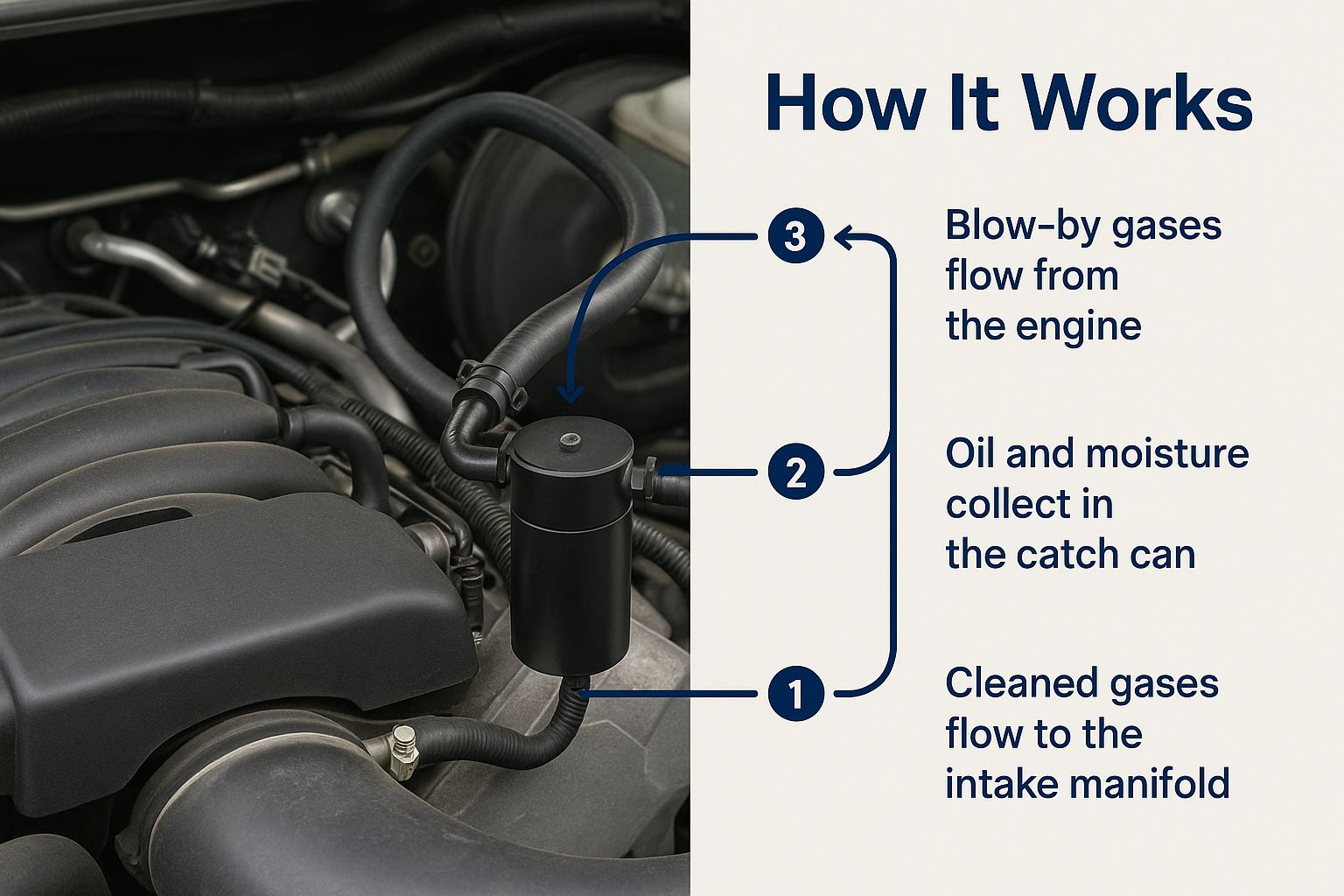
As you can see, the can creates a detour for the crankcase gases, forcing them through a filtration system before they're allowed back into the intake.
The Journey From Crankcase to Clean Air
It all starts with blow-by. Hot, pressurized gases escape past the piston rings and into the crankcase. From there, they exit through the Positive Crankcase Ventilation (PCV) valve. In a standard setup, they’d head straight for the intake manifold, but with a catch can, they’re rerouted into the can’s inlet port first.
This is where the magic happens. Inside the can, the fast-moving gases are forced to slow down and zigzag, usually through a series of baffles or a filter material like stainless steel mesh. This abrupt change in speed and direction makes the heavier oil, fuel, and water vapor condense into liquid droplets. They literally fall out of the air.
Gravity takes over, and these captured contaminants collect at the bottom of the can, safely out of the way. What's left is much cleaner air, which then flows out of the can’s outlet port and continues on to the engine’s intake, ready for combustion.
A good fuel catch can is much more than an empty bottle. The internal design is what makes it work. Baffles and filter media are the key ingredients that actually separate the oil and other junk from the air.
This technology is gaining traction thanks to a global rise in vehicle customization. Owners in major markets like the United States, China, and Germany are investing in smarter ways to protect their engines, which has pushed manufacturers to develop more advanced catch cans with multi-stage filtration. You can learn more about the growing aftermarket for engine protection and see just how big this trend has become.
Open Loop vs. Closed Loop Systems
When you're shopping for a fuel catch can, you'll run into two main types: closed-loop and open-loop. Knowing the difference is crucial for choosing the right one.
- Closed-Loop System: This is the most popular and street-legal option. It catches the gunk and then sends the cleaned air right back into your engine’s intake, just like the factory intended. It keeps your emissions system a complete, "closed" loop.
- Open-Loop System (Vented to Atmosphere): This design also captures contaminants, but instead of recycling the air, it vents it directly into the atmosphere. While it works well, this style is almost always meant for off-road or track use only, as it can violate local emissions laws.
For pretty much everyone driving on public roads, a baffled, closed-loop fuel catch can is the way to go. It delivers the engine protection you want while keeping your car compliant, ensuring your intake stays clean and your engine runs strong for years to come.
Alright, let's take that robotic-sounding section and give it a more human, expert touch. Here’s the rewrite:
The Real-World Benefits of Installing a Catch Can
It's one thing to understand the theory behind a fuel catch can, but what really matters is what it does for your engine out on the road. This isn't just a gadget for hardcore racers; it's a smart, preventative upgrade that pays off in daily driving performance and the long-term health of your vehicle.
The advantages are bigger than just catching a bit of oily gunk. When you keep your engine's intake system clean, you're directly preserving its efficiency, power, and overall lifespan. Let's break down the practical benefits you'll actually feel and see.
Maintains Engine Power and Responsiveness
The biggest win here is stopping carbon from building up on your intake valves. This is a huge deal for modern direct-injection engines. Since fuel is shot straight into the cylinder, it no longer washes over the intake valves and cleans them. Without a catch can, those oily blow-by fumes bake onto the hot valves, creating thick deposits that choke off airflow.
Think of it like trying to breathe through a clogged straw. This buildup slowly strangles your engine, causing a gradual but very real loss of horsepower and torque. By installing a fuel catch can, you're making sure only clean air gets into the combustion chamber. This keeps the intake path wide open, letting your engine breathe the way it was designed to. You'll keep that crisp throttle response and avoid that sluggish, tired feeling that creeps in over time.
Improves Fuel Economy and Efficiency
Those same carbon deposits that steal your power also hit you at the pump. When your valves are caked with grime, they mess up the carefully calibrated air-fuel mixture your engine relies on for an efficient burn. Your engine's computer will try to adjust, but it's fighting a losing battle, leading to wasted fuel and more frequent fill-ups.
A catch can helps your engine run as efficiently as the day it left the factory. By stopping oil and unburnt fuel from contaminating the air coming in, you're paving the way for a cleaner, more complete combustion. Over time, that translates directly to better miles per gallon, saving you real money.
"It keeps the fuel's octane up since the oil is not part of the mixture in the cylinder anymore, it keeps your intake system clean, it increases the reliability of the engine long-term, and it helps maintain a consistent performance level."
At its core, this simple device is just purifying the air your engine breathes, which creates a positive ripple effect through the entire system.
Extends Engine Longevity
This might be the most important benefit of all: a catch can genuinely helps your engine live a longer, healthier life. By filtering out all that nasty stuff, you're not just keeping things clean—you're actively reducing wear and tear on some of your engine's most vital parts.
Here’s a quick look at how a catch can acts as a bodyguard for your engine:
- Reduces Detonation (Knock): When oil vapor gets mixed in with your fuel, it effectively lowers the fuel's octane rating. Lower octane makes your engine more prone to pre-ignition, or "engine knock," a destructive force that can damage pistons and connecting rods.
- Protects Turbochargers: If you have a turbo, a catch can is a must. It stops that oily sludge from gumming up the delicate fins on the compressor wheel and clogging your intercooler, which keeps your boost pressure strong and protects those expensive parts from failure.
- Minimizes Oil Contamination: It prevents blow-by from being recycled back into the crankcase, which helps your engine oil stay cleaner and protect better between changes.
At the end of the day, a fuel catch can is a small investment that acts as a powerful line of defense against the slow, internal damage caused by blow-by. It’s one of the best things you can do to keep your engine running stronger, smoother, and for many more miles down the road.
Choosing the Right Fuel Catch Can for Your Car
Walking into the world of aftermarket parts can feel like a lot, but picking the right fuel catch can doesn't have to be a headache. The truth is, not all cans are created equal. To really protect your engine, you need to look past the shiny finish and focus on what actually works.
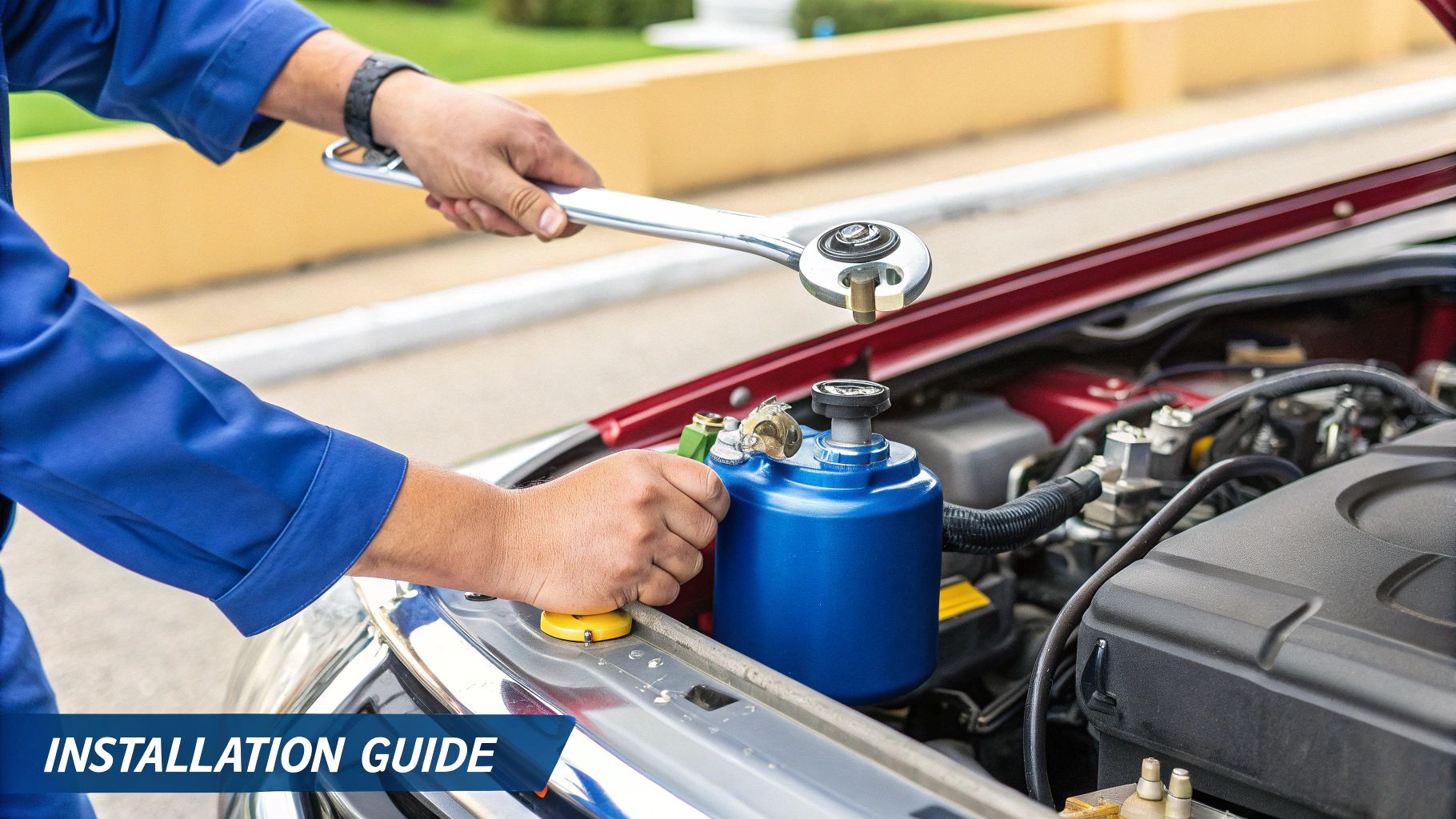
Making a smart choice means you’re getting a part that delivers real-world benefits, not just an engine bay ornament that gives you a false sense of security. Let’s break down the key things to look for so you can make a solid investment in your engine's health.
How Much Capacity Do You Really Need?
The first thing people usually ask about is size, and the answer really comes down to your engine and driving style. A small, tidy-looking can might be tempting, but if it fills up between oil changes, it's not doing its job.
- Daily Drivers: For a standard commuter car, a can with a 2-5 ounce capacity is usually plenty. It’s enough to handle normal blow-by without you having to empty it every other week.
- High-Performance & Track Cars: If you’re running high boost or spending time at high RPMs, your engine is going to produce way more blow-by. Here, you'll want a larger can, something 7 ounces or more, to handle the extra volume during a track day or spirited driving.
You're looking for that sweet spot: a can big enough to be effective but not so huge that finding a place to mount it becomes a nightmare.
Here’s the most important thing to remember: what’s inside the can matters more than anything else. An empty can is just a hollow reservoir. The internal baffling is what actually does the heavy lifting.
A well-designed baffle or filter forces the oily air to twist and turn, which helps knock the oil and fuel vapors out of suspension so they can be collected. Without a good internal system, those contaminants just zip right through and head straight back into your intake.
Comparing Key Features
To pick the best can for your setup, it helps to compare the most important features side-by-side. This table breaks down what to look for and why it's critical for protecting your engine.
Fuel Catch Can Feature Comparison
| Feature | What to Look For | Why It Matters for Your Engine |
|---|---|---|
| Capacity | 2-5 oz for daily driving, 7+ oz for performance. | Ensures the can doesn't overflow between oil changes, preventing gunk from re-entering the intake. |
| Baffling/Filter | Multi-stage baffles, bronze filters, or stainless steel mesh. | This is the core technology. It separates oil/fuel from the air, which is the whole point of a catch can. |
| Material | Anodized billet aluminum for durability. | Resists heat, pressure, and corrosive blow-by chemicals, preventing cracks or leaks in the engine bay. |
| Serviceability | Dipstick for checking levels and a drain plug or removable bottom. | Makes it easy to check if the can is full and simple to empty without making a mess. |
| Port Size | Fittings that match your PCV hose diameter. | Avoids creating a bottleneck in the crankcase ventilation system, which could increase pressure. |
Ultimately, a quality can with a good filter and the right capacity is a far better investment than a cheap, empty can that offers little more than looks.
Material and Build Quality
The material your catch can is made from has a huge impact on how long it will last. You'll mostly find options made from aluminum or, on the budget end, plastic.
Billet aluminum is the gold standard here. It's incredibly strong, handles engine bay heat without breaking a sweat, and stands up to corrosion. Anodized aluminum takes that protection a step further. It might cost more upfront, but a well-made aluminum can is something you'll only have to buy once.
Some cheaper cans use materials that can warp, crack, or become brittle from the constant heat cycles. This is one part where spending a little extra is definitely worth it for peace of mind. It seems other car owners agree; the market for automotive oil catch cans is expected to grow from USD 150 million to USD 300 million by 2032 as more people invest in quality engine protection.
Universal vs. Vehicle-Specific Kits
Your final decision is whether to go with a universal kit or one made specifically for your car.
- Universal Kits: These are typically cheaper and let you choose where to mount the can. The trade-off? You'll have to figure out the hoses, clamps, and fittings yourself, so it requires a bit more DIY skill.
- Vehicle-Specific Kits: These are engineered to be a perfect, bolt-on solution. They include custom brackets, pre-cut hoses, and all the hardware you need, which makes for a much cleaner and easier installation.
While a catch can is a must-have for performance cars, the same ideas about clean fuel systems apply everywhere—even on the water. For any boaters out there, check out our guide to choosing and maintaining a boat fuel tank for tips on keeping your marine engine running smoothly.
So, you’re thinking about installing a fuel catch can yourself? Good on you. It’s one of those projects that sounds more intimidating than it actually is. Let's break down what's really involved so you can decide if it’s a weekend job for you or one for the pros.
This isn't a step-by-step guide for a 2018 Mustang or a specific boat engine, but a look at the general process. Once you see the big picture, you'll have a much better feel for it.
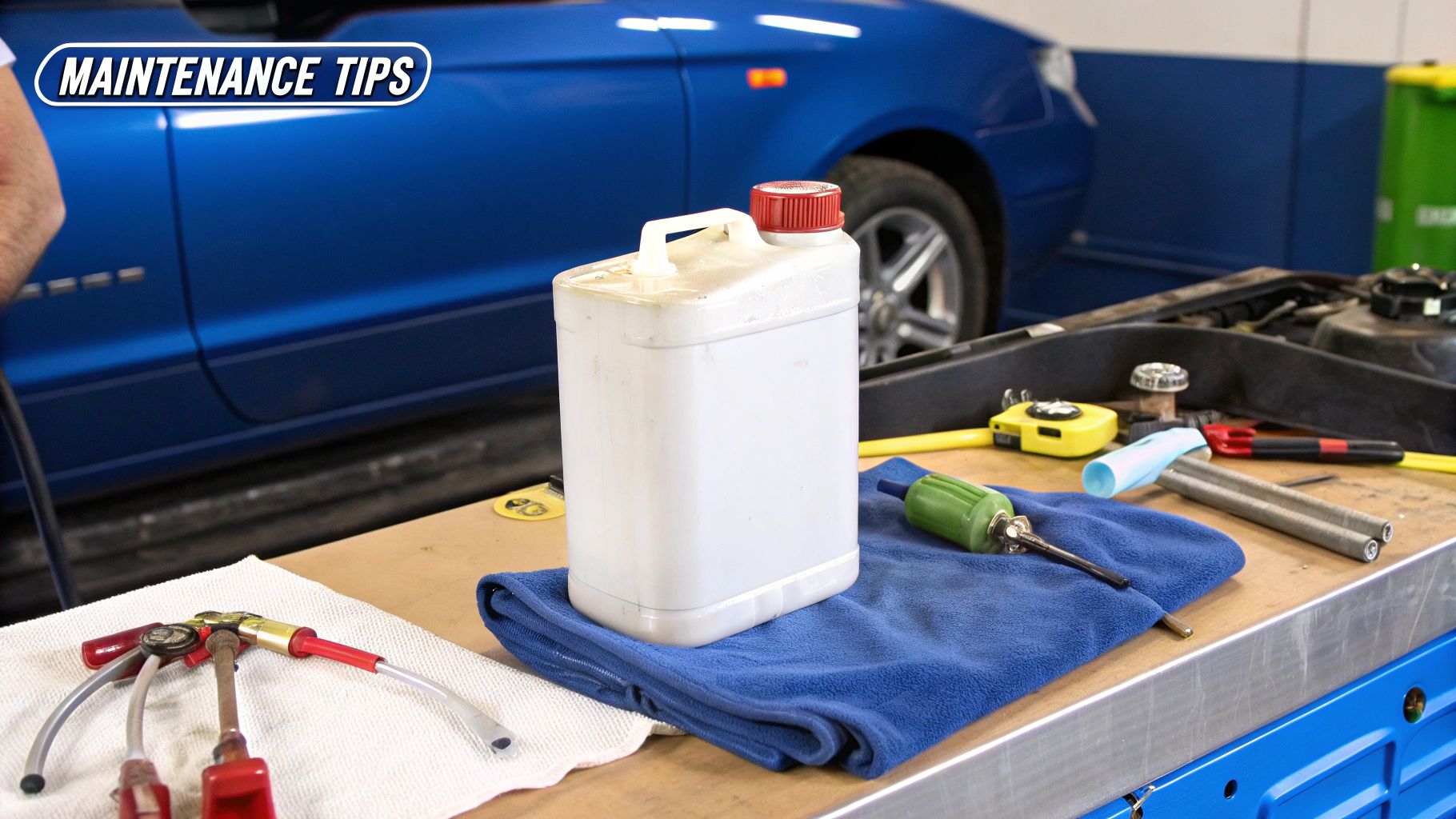
Honestly, most of these installations are pretty straightforward. If you have some basic hand tools and about an hour to spare, you can usually get it done. It's a satisfying project that connects you a little more to what's happening under the hood.
What the Installation Actually Looks Like
At its core, all you're doing is rerouting some plumbing. You're simply placing the catch can in the middle of the path that crankcase vapors already travel.
-
Find the PCV Hose: Pop the hood and locate the Positive Crankcase Ventilation (PCV) system. You're looking for a rubber hose that usually runs from a valve on the engine's valve cover over to the intake manifold. This is the superhighway for all that oily gunk.
-
Mount the Can: Next, find a good spot for the catch can itself. You want it somewhere stable, away from anything that gets scorching hot or moves around, but close enough that you can easily reach it to drain later. Good kits often include brackets designed for your specific vehicle, which makes this step a breeze.
-
Run the New Hoses: This is the main event. You'll disconnect the factory PCV hose. Then, you run a new hose from the PCV valve to the port labeled "IN" on your catch can. A second new hose goes from the "OUT" port on the can to the spot on the intake manifold where the original hose used to connect.
And that's the loop. Now, all those vapors have to pass through the catch can's filter media before they ever see your intake system again.
The single most critical part of this job is getting the routing right and making sure everything is sealed. Kinked hoses are a no-go—they can block flow and create unwanted pressure. And every clamp needs to be snug to avoid vacuum leaks, which can mess with your engine's performance.
A Few Common Mistakes to Sidestep
Even simple jobs have their pitfalls. Keep an eye out for these common slip-ups to save yourself a headache.
- Lazy Hose Routing: Don't just let the hoses flop wherever they land. Make sure they aren't resting on a hot exhaust manifold or rubbing against a sharp bracket. A few zip ties can go a long way in keeping things neat and secure.
- Mixing Up In and Out: It happens more than you'd think. Double-check that you've connected the lines to the correct inlet and outlet ports. If you reverse them, the catch can does absolutely nothing.
- Forgetting the Final Check: Once you think you're done, go back and give every clamp and fitting a final once-over. A single loose clamp can lead to a vacuum leak that’s a real pain to track down later.
Knowing these steps and potential traps should give you a clear idea of what the job entails. From here, you can confidently decide whether to grab your tools or make a call to your favorite mechanic.
Got Questions About Fuel Catch Cans? Let's Clear Things Up.
Even after seeing how they work, you've probably got a few questions. That’s a good thing! When you're thinking about adding any new part to your engine, especially one that protects it, you want to have all the facts straight.
Let's walk through some of the most common questions people ask about fuel catch cans. Getting solid answers will help you decide if one is right for you and give you peace of mind.
How Often Do I Need to Empty a Fuel Catch Can?
There isn't a one-size-fits-all answer, but a great rule of thumb is to check it every time you change your oil. For most people, that's every 1,000 to 3,000 miles. Just make it part of your regular maintenance routine.
How fast it fills up really comes down to a few things:
- How You Drive: If you’re pushing your engine hard with high RPMs or taking it to the track, you’ll see more blow-by than someone with a gentle daily commute.
- The Weather: Colder climates mean more condensation inside the engine. You’ll find more of that milky, watery gunk in the can during winter months.
- Your Engine's Health: An older, high-mileage engine or a modified one naturally produces more blow-by, which means you'll be emptying the can a bit more often.
The key is to get to know your engine's habits. After checking it a couple of times, you'll get a feel for how quickly it fills, letting you set a schedule that ensures it never overflows.
Will a Fuel Catch Can Void My Warranty?
This is a huge, and completely valid, concern for anyone with a newer vehicle. The good news is that in the United States, the Magnuson-Moss Warranty Act is on your side. This federal law prevents manufacturers from voiding your warranty just because you installed an aftermarket part.
To deny a warranty claim, the manufacturer has to prove that the aftermarket part you installed—in this case, the fuel catch can—was the direct cause of the failure you're claiming.
With that said, some dealerships can be stricter than others. Your best bet is to always choose a high-quality, well-designed catch can and make sure it's installed perfectly. A cheap, leaky unit could cause problems, so proper installation is everything. If you’re still worried, a quick chat with your service advisor beforehand can go a long way.
Are Fuel Catch Cans Legal Everywhere?
This one is a bit of a gray area because it really boils down to your local and state emissions laws. In places with extremely strict standards, like those set by the California Air Resources Board (CARB), any part that touches the emissions system might need a special certification, called an Executive Order (EO) number, to be street legal.
You'll notice many catch cans are sold for “off-road use only.” This is how manufacturers navigate these complicated rules. If you live in a state with emissions testing, you absolutely have to do your homework. Check your local laws and research the specific product you’re considering. Look for cans that are advertised as 50-state legal or specifically CARB-compliant to avoid any future headaches. This ties right into keeping your entire fuel system safe and compliant, a topic we dive into in our guide to complete boat fueling safety.
What's the Difference Between a Catch Can and an Air Oil Separator?
They both tackle the same problem—nasty blow-by—but they go about it in different ways.
A fuel catch can is a pretty straightforward system. It filters the crankcase vapors and collects the oil, fuel, and water in a small tank that you have to empty by hand. It's simple, very effective, and the perfect choice for most cars on the road today.
An Air Oil Separator (AOS), on the other hand, is a more complex, active system. It also separates out the gunk, but instead of just holding it, an AOS is plumbed to automatically drain the captured oil right back into the engine's oil pan. These are usually more expensive and are a popular choice for dedicated race cars where a "set it and forget it" solution is a bigger priority.
For the vast majority of drivers, a quality baffled catch can offers all the engine protection you need without the extra cost and complexity of an AOS.
At CLiX Fueling Solutions, we're obsessed with making every part of owning a vehicle—or a boat—safer and more efficient. A catch can protects your engine from the inside, while our systems protect your boat, the dock, and the water from the outside by preventing messy and dangerous fuel spills. See how you can fuel up with complete confidence at https://clixfueling.com.

